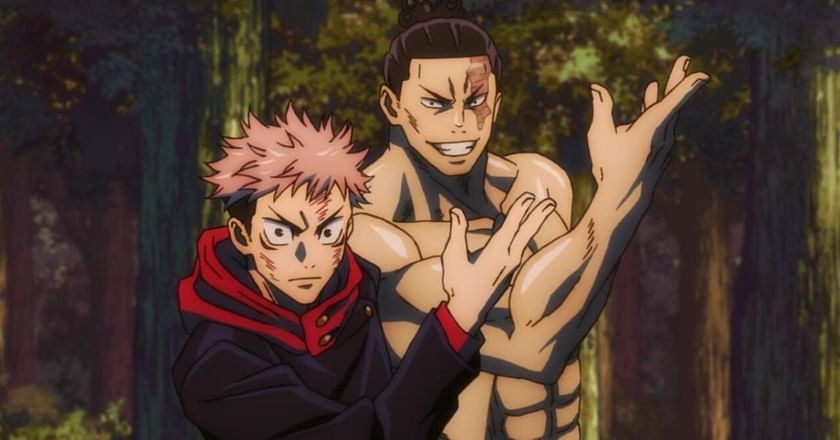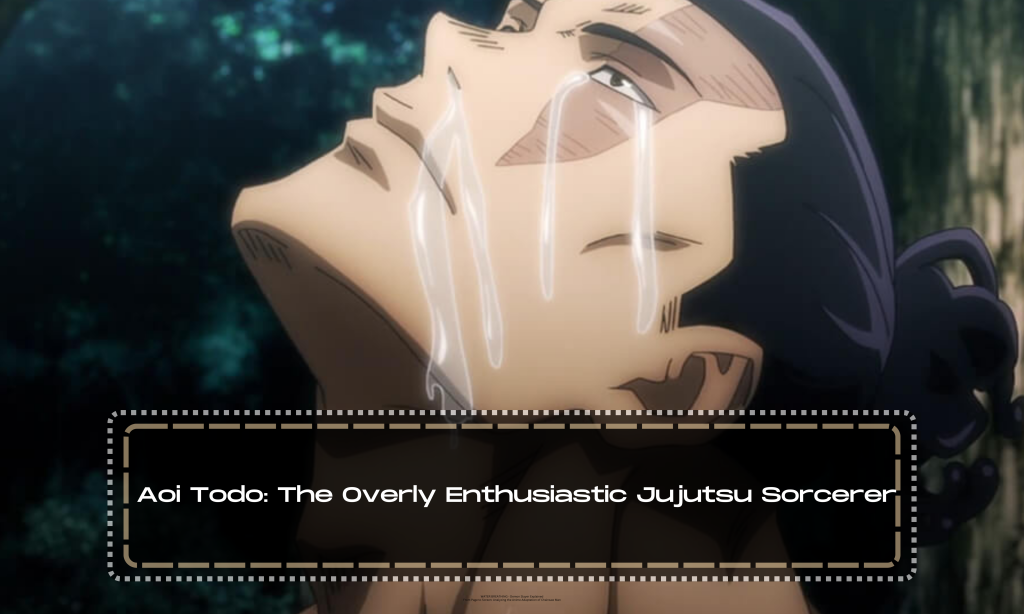Aoi Todo: The Overly Enthusiastic Jujutsu Sorcerer
In the vast world of anime, there are characters of all shapes and sizes, each with their unique quirks and qualities. But among the plethora of personalities, there are some that stand out in the most unexpected and entertaining ways. One such character is Aoi Todo, the overly enthusiastic Jujutsu Sorcerer. If you’ve watched “Jujutsu Kaisen,” you know exactly who I’m talking about. Aoi Todo, with his larger-than-life personality and over-the-top antics, is a character that adds a whole new level of excitement to the series.
In this 4000-word blog post, we’re going to take a deep dive into the world of Aoi Todo, exploring his character, his role in “Jujutsu Kaisen,” and the reasons why he has become a fan-favorite due to his hilariously enthusiastic nature.
Aoi Todo: The Introduction

Before we get into the nitty-gritty details of Aoi Todo’s character, let’s start with a brief introduction. Aoi Todo is a Jujutsu Sorcerer and a second-year student at Tokyo Metropolitan Magic Technical High School. He is a tall, well-built young man with striking red hair, which matches his fiery personality perfectly. Todo is known for his distinctive style, which includes a flashy black and red tracksuit, sunglasses, and a headband that says “Jujutsu High” – all of which contribute to his unique and memorable appearance.
But it’s not just his looks that set Aoi Todo apart; it’s his personality that truly makes him a standout character. Todo is exuberant, loud, and enthusiastic to a fault. He’s the type of guy who’s always ready to jump into action, often without thinking about the consequences. His over-the-top reactions and zest for life make him an absolute joy to watch in the series.
Todo’s Powers and Abilities
In the world of “Jujutsu Kaisen,” Jujutsu Sorcerers are individuals who fight against curses using powerful techniques and cursed energy. Aoi Todo is no exception, and he possesses some impressive powers and abilities that make him a formidable force in the Jujutsu world.
One of Todo’s most remarkable abilities is his immense physical strength. He can easily overpower curses with his bare hands, and his punches pack a punch (pun intended) that can send even the toughest curses flying. His raw power and combat skills make him a valuable asset in battles against curses, and he’s not one to hold back when it comes to taking on these supernatural threats.
In addition to his physical prowess, Todo is also proficient in using cursed energy. He can create barriers and use domain expansion, a technique that allows him to control and manipulate a specific area, turning it into a deadly battlefield. Todo’s domain expansion, called “Boogie Woogie,” adds another layer of complexity to his already dynamic fighting style.
Todo’s Philosophy and Values

Underneath Todo’s bombastic exterior, there’s a more complex character with a unique philosophy on life and combat. Todo firmly believes in “strong people” and is constantly seeking out individuals he deems as such. He values strength above all else and has a somewhat unconventional way of determining who is strong and who isn’t.
One of Todo’s defining characteristics is his obsession with “types.” He believes that people can be categorized into specific types based on their personalities and attributes. He’s always on the lookout for individuals who fit into his ideal “type,” and he’s quick to judge and label people based on his own criteria.
Todo’s philosophy on strength and his obsession with types add an interesting layer of depth to his character. While his approach may be unorthodox and humorous, it’s a reflection of his unwavering commitment to his beliefs, making him a character that’s both entertaining and thought-provoking.
Todo’s Relationships
Aoi Todo’s interactions with other characters in “Jujutsu Kaisen” are some of the most entertaining moments in the series. His overly enthusiastic and often inappropriate comments and actions create hilarious dynamics with his fellow Jujutsu Sorcerers.
One of his most notable relationships is with Satoru Gojo, one of the most powerful Jujutsu Sorcerers in the series. Todo idolizes Gojo and considers him the ultimate example of a “strong person.” Their interactions are filled with comedic banter and Todo’s over-the-top admiration for Gojo, which often leaves Gojo exasperated but amused.
Todo’s interactions with the series’ protagonist, Yuji Itadori, are equally entertaining. Despite their differences in personality, Todo and Yuji develop a unique bond based on their shared experiences as Jujutsu Sorcerers. Todo’s mentorship of Yuji adds depth to his character, showcasing his willingness to help those he deems as having potential.
Todo’s Humorous Moments

Now, let’s dive into the real heart of Aoi Todo’s character: his humorous moments. “Jujutsu Kaisen” is known for its blend of action, horror, and comedy, and Todo is a character who embodies the comedic aspect of the series.
One of the recurring gags involving Todo is his obsession with “cursed techniques.” He believes that a person’s strength is directly related to the quality of their cursed technique, and he often asks people about their techniques, expecting them to be impressive. His disappointment when he encounters someone with an underwhelming technique is both hilarious and endearing.
Todo’s penchant for making grand entrances is another source of comedy in the series. Whether he’s crashing through a window or dramatically announcing his arrival, Todo’s entrances are always over-the-top and accompanied by his signature catchphrase, “I’m Aoi Todo, but you can call me Todo Aoi!”
But perhaps one of the most iconic and comedic moments involving Todo is his encounter with Principal Yaga. In this memorable scene, Todo accidentally walks in on Principal Yaga in a compromising position, leading to an awkward and side-splitting interaction that perfectly captures Todo’s irreverent and unpredictable nature.
Todo’s Growth and Development
While Aoi Todo is primarily known for his comedic moments, it’s important to note that his character also undergoes significant growth and development throughout the series. Underneath his brash exterior, Todo is a character who is constantly learning and evolving.
One of the key moments in Todo’s character development occurs during the Kyoto Goodwill Event arc, where he faces off against another Jujutsu Sorcerer, Mai Zenin. This battle forces Todo to confront his own beliefs about strength and types. It’s a moment of self-reflection for him, and it adds depth to his character as he begins to question the rigid categories he’s imposed on people.
Todo’s mentorship of Yuji Itadori also plays a crucial role in his growth as a character. He learns the value of teamwork and cooperation, traits that were not initially a part of his philosophy. As he becomes more connected to his fellow Jujutsu Sorcerers, he starts to see the world in a different light, and his interactions become less about types and more about genuine connections.
Why Fans Love Todo
Aoi Todo has quickly become a fan-favorite character in “Jujutsu Kaisen,” and it’s not hard to see why. His larger-than-life personality, humorous antics, and memorable catchphrases have endeared him to viewers around the world. But there’s more to Todo’s appeal than just his comedic moments.
First and foremost, Todo’s enthusiasm is infectious. His unbridled passion for life and combat resonates with viewers who appreciate characters who approach challenges with unyielding determination. His ability to find joy and excitement in even the most dire situations is both inspiring and entertaining.
Additionally, Todo’s character adds a refreshing layer of comedy to “Jujutsu Kaisen.” While the series certainly has its fair share of intense and dark moments, Todo provides a welcome dose of humor that keeps the tone balanced and enjoyable. His interactions with other characters, especially Satoru Gojo, provide some of the most memorable comedic moments in the series.
Furthermore, Todo’s growth and development as a character make him relatable to viewers. We all have our preconceived notions and beliefs, and watching Todo question and evolve beyond his own is a journey many can empathize with. His journey from a one-dimensional character obsessed with “types” to a more well-rounded and compassionate individual is a testament to the depth of character development in “Jujutsu Kaisen.”
Conclusion

In the world of anime, there are characters who leave a lasting impression, and Aoi Todo, the overly enthusiastic Jujutsu Sorcerer from “Jujutsu Kaisen,” is undoubtedly one of them. With his bombastic personality, hilarious antics, and unexpected moments of growth, Todo has become a beloved character for fans of the series.
While Todo may start off as a caricature of an overly enthusiastic fighter, he ultimately proves to be a complex and multidimensional character. His journey from a strict believer in “types” to someone who values genuine connections and teamwork is a testament to the depth of storytelling in “Jujutsu Kaisen.”
So, the next time you find yourself watching “Jujutsu Kaisen” and Aoi Todo graces the screen with his presence, take a moment to appreciate the humor, the growth, and the sheer enthusiasm that he brings to the series. Aoi Todo is not just an overly enthusiastic Jujutsu Sorcerer; he’s a character who adds heart, laughter, and a whole lot of fun to the world of anime.
That’s me, Andreea Blaga, author of the blog anime-everything.com. I work as a content creator in the US. I am also passionate about Japanese Anime.


Related post
The Legacy of Monsters University What We Learned About Teamwork and Ambition
The Legacy of Monsters University: What We Learned About Teamwork and Ambition The animated film...
Mar
Unraveling the Mystery A Deep Dive into Dark Winds
Unraveling the Mystery: A Deep Dive into Dark Winds In the vast landscape of modern...
Mar
The Cultural Impact of Emilia Pérez in Mexico and Beyond
Emilia Pérez is a name that resonates beyond the borders of her homeland, Mexico. With...
Mar
Just One Look The Power of First Impressions in Life and Love
In the world we live in, first impressions hold a unique and powerful significance. Whether...
Mar
Tropic Thunder and the Limits of Comedy What Can We Learn Today?
Tropic Thunder and the Limits of Comedy: What Can We Learn Today? Tropic Thunder, released...
Mar
Blazing Trails The Cultural Impact of Up in Smoke on Cannabis in Hollywood
Blazing Trails: The Cultural Impact of Up in Smoke on Cannabis in Hollywood On this...
Mar